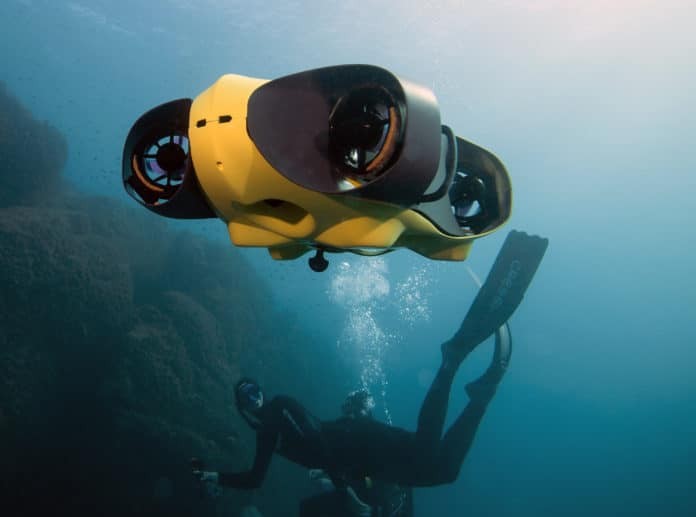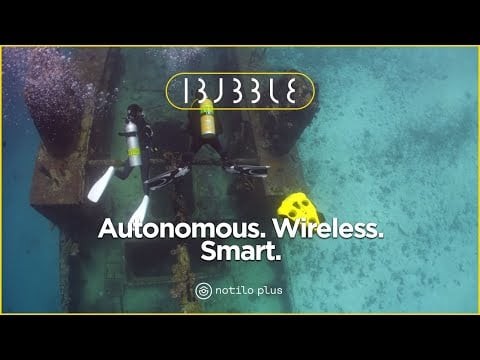In my younger days, I was a bit of a techie and an early adopter. When the first personal computers hit the market, I spent over a month’s salary to get one. Before that time, computers required entire buildings and teams of scientist to keep them operational. It was a start in a great shift. The memory in my phone’s SIM card today is greater than the memory on my first computer even counting the expanded memory board I built to give it more. While not as much impact on mankind as the introduction of the personal computer, the advancements in computer powers is also seen in other devices such as aerial drones and Remotely Operated Vehicles or ROV. Now, we are seeing the combination of these two technologies being applied underwater. Just as advancement in aerial drones is bringing flying devices to the reaches of more people including limited range toys, there is an up whelming surge in underwater drones. We are now seeing affordable devices geared to the desires of divers.
What to call them seems to be more marketing orientated than traditional naming. NOAA defines an Autonomous Underwater Vehicle (AUV) as a vehicle that operates independently of the ship and has no connecting cables. They define an ROV as connected to an operator on the ship. Today we have underwater devices that meet both these requirements and devices that meet neither.
The first thing that comes to my mind when ROV or AUV is mentioned is searching for deep shipwrecks. The late Paul Allen had two surface vessels, the 126-meter Octopus and Research Vessel Petrel, that were used to find about 20 significant WWII wrecks. I would love to have a vessel like one of those to search my favorite dive destination but would need to win a few lotteries first. These ships were platforms that used both AUV and ROV equipment. AUV and ROV type vessels are used in support of oceanography studies as well as environmental science projects. ROV equipment is often used to supplement surface based side-scan sonar in search and recovery missions by Coast Guard or law enforcement.
Over the years as technology improved and size and prices came down, the use of an ROV in port security was advanced. There was also an uptake in other monitoring activity such as checking underwater pipelines and dams. Actions that were cost prohibitive in the past became something that a small corporation or government unit could afford. The advanced technology also brought ease of use. Smaller less complicated ROV units can be controlled with only a day or two of practice, where the more advanced units would take a month or more to become certified in their use.
Diver’s Drones
We are now seeing what I will call the personal underwater drones. Currently, the prices are still too high for the average diver, however, they may be in a range that a dive club could afford. Someone who is a dedicated amateur wreck finder may also feel the cost is reasonable. Like the personal computer and aerial drones how they will be used will be an individual application. While at DEMA 2018, I talked to a couple of companies that were bringing these personal underwater drones to market. I also talked to a company that produces industrial ROV that ran upward of $100,000.
How To Control An Underwater Drone.
Radio controlled planes and helicopters have been around for decades. The aerial drone of today is an advancement and computerization of those older forms. Transmitters are more powerful than before while still being smaller and using less power. The higher level drones include advanced technology such as crash avoidance and “follow me” attributes. They also provide a platform that a high definition camera can be mounted. With miniaturization of transmitter devices, the camera can broadcast a live signal back to the operator.
Many of the advancements in aerial drones apply to underwater drones as well. There are some different requirements for waterproofing and pressure considerations as well as control limitations. Radio signals do not have much range underwater. Trying to control an underwater vessel by radio is not really practical. The ROV method is an option for the personal diver vessel if the diver is on the surface. The surface operator could send an ROV down to check out a site before the divers go down. I have been on a number of dive trips, where we were looking for new dive sites. Not having a budget for top quality side scan sonar, we would locate possible sites with a recreational style side scan sonar. Then a pair of divers would dive down and look around. If visibility was poor, the divers would often perform a search pattern to try to locate the item. Many times the search revealed nothing. Having an ROV slipped over the side to go down and take a look is much more efficient. Also, the time searching is not limited by air supply or decompression time.
The connection between the operator and the personal underwater drones can be a hybrid system. Some new systems on the market or coming to market do have a tether from the boat to the drone. This tether will provide a path for the controls and feedback of the video from the drone. Another approach is for the drone to pull a float. Much like having a diver down flag, the float will show you where the drone is underwater. However, in this case, the float contains a transmitter/ receiver that relays signals by cable to and from the drone but wireless to the operator. This lessens the chance of damage to the tether by boat traffic. The BW Space by Youcan Robotics uses this method from the surface.
The other means of control is where the operator is underwater. This is basically an autonomous operation. The operator/diver gives the personal underwater drone a program to follow and the drone executes the program. These programs are often related to the diver or the remote they have. The drones also are able to avoid obstacles on their own and “recognize” the diver from others.
At DEMA 2018, iBubble did a demonstration of some of their autonomous modes. They are able to tell the drone to:
- Follow: iBubble positions itself behind you, slightly tilted and above. It films you as well as the environment ahead of you: It’s the perfect scenario when you are diving towards the dive site!
- Lead: iBubble positions itself ahead of you and films what you see – just like a first-person view!
- Side: iBubble positions itself to your right and films you from the side. A scenario well adapted if you have a reef or a wreck on your left.
- Circle: iBubble circles around you and films inwards. Perfect for filming the group!
- Come: iBubble heads towards you and shuts down its propellers once close to you. You can then grab it and film a specific point of interest. Once you let it go, iBubble turns its propellers back on and switches back to the last used scenario.
- Stay: iBubble stops and stabilizes itself at this depth. You can move away from it while it films a panoramic view of the environment.
- Dive: iBubble positions itself behind you and tilts down when you dive deeper. This scenario is perfect for freedivers and divers getting down to a wreck
The diver can instruct the drone to maintain a distance away between 1 meter to 20 meters. If the drone loses the diver, it will do as all good dive buddies will do. It will stop and attempted to find the diver. If it is unable to locate the diver, it will slowly return to the surface while actively looking to reacquire the diver. When it does it will return to the diver and follow the current instructions. If the battery drops below a set percentage of power remaining, the drone will revert to the “come” mode and returned to the diver.
I wish my dive buddies were that attentive.
Coming to a Dive Center Near You.
DeeperBlue.com hosted the Breathold & Brew Industry Party at DEMA 2018. It was an evening to mingling and see old friends and meeting new ones, and of course a lot of shop talk. I was pulled into a conversation where dive center operators were sharing ideas on how they were considering adding underwater drones into their dive sessions and even training. In many dive centers, a personalized video of your dive is a popular item. A diver could rent a drone, get a fast rundown on the options and have a very personalized dive video. Much better than an action cam on a selfie stick.


